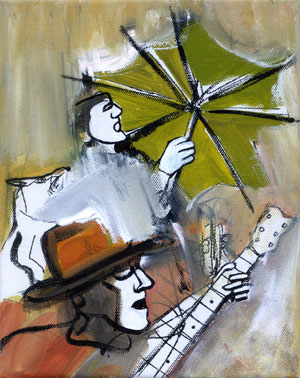 Every Saturday, we’ll be posting a new illustration by David Lester. The Mecca Normal guitarist is visually documenting people, places and events from his band’s 27-year run, with text by vocalist Jean Smith.
Every Saturday, we’ll be posting a new illustration by David Lester. The Mecca Normal guitarist is visually documenting people, places and events from his band’s 27-year run, with text by vocalist Jean Smith.
In the 1960s, Percy was an art director at a New York ad agency and very tuned into the present tense. Very, very tense. Intense. What young people called uptight. Generationally positioned between Percy and his young son Frank were the hippies, the yippies, the flag-burners, draft dodgers and war protesters.
Percy was 20 years old when Frank was born in 1959, a time of relative calm. A euphoric re-grouping was in progress after the Second World War had dismantled family life. The car changed the way the landscape was organized; sub-urban life included the centralized grocery stores, and consumers drove to buy assembly-line processed, over-packaged foods containing preservatives developed after the use of boric acid was banned. The local green grocer and back-lane deliveries of ice, coal and vegetables were a thing of the past. The milkman hung in the longest, perhaps because the milk bottle needed to end up back in the milk producers’ hands. Milk distribution featured what an ad executive sitting in an agency board meeting on Madison Avenue might call a hiccup. Perhaps the quantity of milk being consumed—and spilled—by families with two-point-five children using it—tsunami-like—for breakfast-cereal options and chocolaty afterschool drinks contributed to the equation. The heavy bottles, once in paper grocery bags, were lifted into shopping carts by teenage boys positioned at the end of the checkout-line conveyer belt, who also rolled the groceries out to the parking lot, to pick them up and set them into the trunk of the car while the housewife opened car doors and frowned, calling the names of the 2.5 children who were not paying enough attention to cars driven by other housewives pulling in and pulling out. As they drove home without seatbelts, the less than 1.5 miles from the grocery store, the cold milk bottles were doing something exciting in the trunk; they were forming condensation, which resulted in the paper bags getting wet and breaking open and with the husband not yet home from work and dinner needing to be made and the frozen peas and quarts of vanilla ice cream melting, there wasn’t anyone around to bring the groceries in and with two out of the four bags wet from the milk bottles, it seemed logical to keep the milkman in the picture. Not that actual logic was what was driving the re-arrangement of society in the late 1950s into the swinging ’60s.






